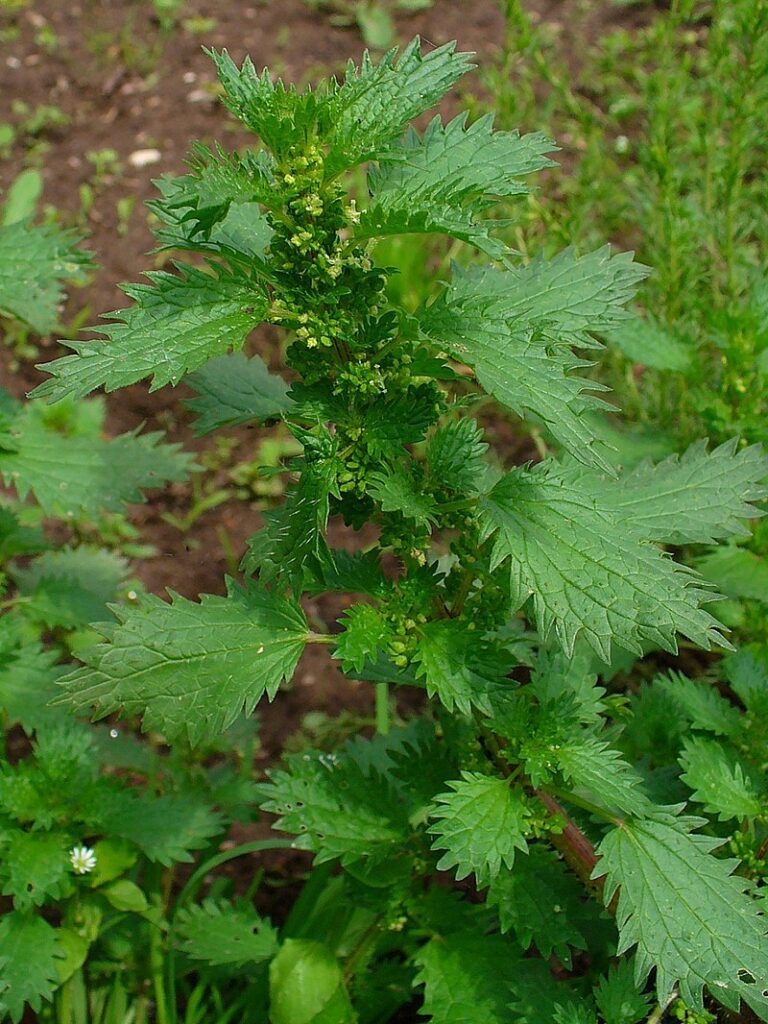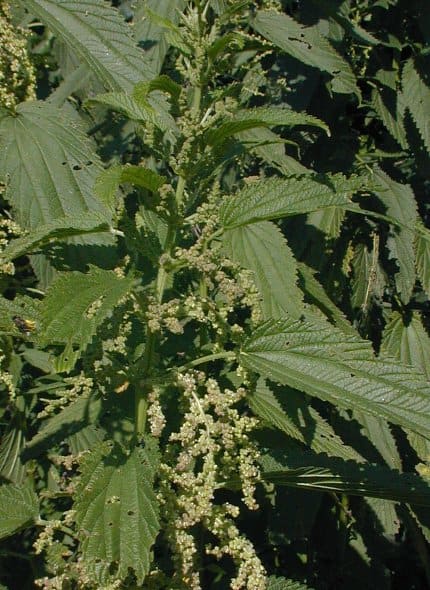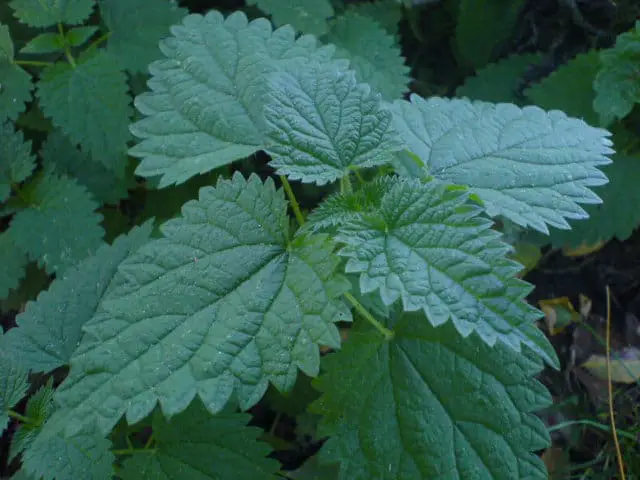Stinging nettle is also also known by the names Urtica dioica, false nettle, and just nettle. It is a plant that was originally from Europe and Asia. Today, it’s also in North America. The plant is most well known for its stinging hairs, which can cause an itchy and painful rash when it comes into contact with the skin. The sharp hollow hairs pierce the skin and release formic acid, which can then itch for a few hours up to a few days.
Despite its reputation as a nuisance plant, stinging nettle has been used as a medicinal herb and a culinary ingredient for centuries. In the past, its dried leaves have been fed to livestock during the cold winter months. But how is a plant that stings you if you touch it with your bare skin considered edible?

Is Stinging Nettle Edible?
Yes, you can eat stinging nettle, but it must be cooked first. You can never eat stinging nettle raw.
When you first learn that you can’t eat stinging nettle raw and that raw stinging nettle will sting your skin, it may sound like you should avoid it at all costs. However, there are a lot of highly nutritious edible plants that can only be consumed in particular ways. Some examples include cherries, which you can eat raw but should never swallow the seeds. Sushi is definitely meant to be properly prepared before consumption. Elderberry syrup is a delicious treat, but you can never eat elderberries raw.
Stinging nettle is similar. It’s a highly nutritious food source that tastes a lot like spinach and can be used to replace kale or spinach in a lot of recipes. However, it can never be eaten raw under any circumstances.
It is important to understand the different parts of the stinging nettle plant and how they are used. The most commonly used parts of the plant are the nettle leaves and the stem, although the roots and seeds can also be used in certain recipes. Younger leaves taste better than older leaves, which often taste more bitter.
Stinging nettle leaves are rich in vitamins and minerals, including vitamins A, vitamin C, vitamin K, calcium, and iron. They also contain flavonoids and other compounds that are believed to have anti-inflammatory and antioxidant properties. In some cultures, stinging nettle leaves have a long history of use as a natural remedy for conditions such as seasonal allergies, hay fever, joint pain, and urinary tract infections.
In terms of culinary use, stinging nettle leaves can be used in a variety of dishes, such as soups, stews, and pastas. Nettle pesto is particularly popular. All parts of the plant can also be cooked up in olive oil and served with salt and pepper. Many people prefer to blanch stinging nettle. The leaves can also be used to make nettle tea, either on their own or mixed with other herbs.
When using stinging nettle leaves for any kind of cooking, it is a good idea to first blanch them in boiling water for a few seconds to remove the stinging hairs. This way, you know you’ll be safe and can stop worrying about the possibility of accidentally touching the plant with any bare skin.
Stinging nettle stems are also edible, although they are not as commonly used as the leaves. The stems can be used in the same way as asparagus, either boiled or roasted and have a similar taste.
Stinging nettle roots and seeds are less commonly used in cooking, but they can still be incorporated into certain recipes. The roots can be roasted and ground to make a coffee substitute, while the seeds can be used as a seasoning or added to bread and other baked goods. They can also be sprinkled over a salad.
While stinging nettle is generally considered safe for consumption, there are some precautions that should be taken. As mentioned earlier, the plant’s stinging hairs can cause a painful rash when they come into contact with the skin, so it is important to wear gloves and protective clothing when harvesting the plant. Additionally, people with certain medical conditions, such as low blood pressure or kidney problems, should consult with a healthcare professional before consuming stinging nettle.
With its rich nutritional profile and unique flavor, stinging nettle is a versatile ingredient that is worth exploring in the kitchen.

Foraging For Stinging Nettle
Foraging for wild foods is an ancient practice that has seen a resurgence with modern outdoor enthusiasts. Among the many wild foods available, stinging nettle is a popular choice for foragers. While the idea of harvesting a plant with stinging hairs may seem daunting, with a little knowledge and preparation, foraging for stinging nettle can be a rewarding and delicious experience.
First, it is important to identify the plant correctly. Stinging nettle is a perennial plant that can grow up to six feet tall. It has heart-shaped leaves with serrated edges and is covered in stinging hairs. The plant grows in moist soil and is commonly found in shaded areas such as forests, riverbanks, and disturbed areas.
When harvesting stinging nettle, it is essential to wear protective clothing like long sleeves and gloves to avoid contact with the stinging hairs. The hairs contain a mixture of chemicals that can cause a painful, itchy rash, similar to that caused by poison ivy. While the rash is not dangerous, it can be uncomfortable and long-lasting, so it is important to take precautions.
Once you have identified a patch of stinging nettle, the best time to harvest is in the early spring before the plant has flowered. At this time, the leaves are young and tender, and the flavor is at its best. As the plant matures, the leaves become tougher and more bitter.
This edible plant flowers as soon as late spring. When it does, the flavor is already changing. You’ll see small white flowers on the female plants when this happens. The flowers are female flowers and contain ovaries. They grow in strands off of the leaf axils.
To harvest stinging nettle, use a pair of scissors or pruning shears to cut off the top few inches of the plant. Place the fresh leaves in a paper bag or another breathable container so the plant is still getting air, but the leaves will definitely not accidentally touch anyone’s bare skin.
Make sure to only take a few leaves from each plant, as overharvesting can harm the plant and reduce future yields. It is also important to leave some of the plants untouched, as they provide habitat and food for insects and other wildlife.
Use gloves to avoid contact with the stinging hairs, and rinse the leaves thoroughly in cold water to remove any dirt or insects. The stinging nettle can then be blanched in boiling water briefly to remove the stinging hairs, or it can be used directly in recipes such as soups, stews, and pesto.



Lookalikes
Stinging nettle has three common lookalikes. They are also edible. They are known as wood nettle (Laportea canadensis), dwarf nettle (Urtica urens), and slender nettle (Uritica gracilis). Dwarf nettle is smaller than stinging nettle and has the most painful sting. Slender nettle has less of the sharp stinging hairs than the other common nettles. Wood nettle has alternating leaves. The general guidance for foraging these lookalikes is the same, though. Be careful of the stinging hairs, and always blanch them before consuming them.
Guidelines For Harvesting Stinging Nettle
It is important to follow some basic guidelines to ensure that you are harvesting the plant safely and sustainably. Here are some tips for responsible foraging:
- Only harvest stinging nettle from areas that have not been treated with pesticides or other chemicals.
- Always wear protective gear while harvesting this plant.
- Harvest only a small portion of the plant, leaving enough for future growth and for other animals that may depend on the plant for food.
- Avoid harvesting stinging nettle from areas with heavy foot traffic, as this can damage the plant and reduce future yields.
- Take care to identify the plant correctly and avoid any poisonous lookalikes.
- Always, always, always cook stinging nettle. Never eat it raw.
Enjoy Your Foraging Adventure!
Foraging for stinging nettle is a great way to connect with nature and learn about wild foods. While the tiny hairs are certainly a danger, they shouldn’t stop you from seeking out this great plant with nutritious and medicinal benefits. Plus, as any forager knows, it’s just satisfying seeing what’s out there growing around you in nature. Look for stinging nettle in the early spring, and remember to be careful and use gloves and scissors if you plan on bringing any home.
Recent Posts
The only venomous snakes in Washington State are Northern Pacific Rattlesnakes. The Northern Pacific Rattlesnake (Crotalus oreganus oreganus) is a sub-species of the Western Rattlesnake. Anyone...
Skunks are not classified as true hibernators. But they go into a state of torpor when the weather gets cold. Skunks are light sleep hibernators, along with opossums, bears, and raccoons. ...

